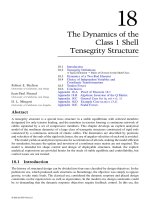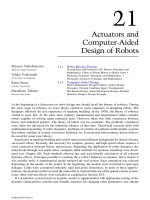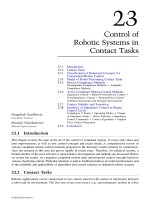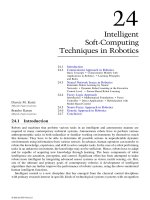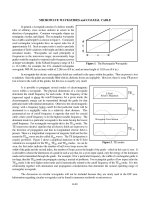Tài liệu Modeling, Measurement and Control P30 pptx
Bạn đang xem bản rút gọn của tài liệu. Xem và tải ngay bản đầy đủ của tài liệu tại đây (530.75 KB, 3 trang )
FIGURE 28.30
End-effector for automatic refueling. (From Leondes, C.T.,
Mechatronic Systems Techniques and
Applications,
Vol. 2, Gordon & Breach, Amsterdam, 2000. With permission.)
FIGURE 28.31 Event structure of the docking process. (From Leondes, C.T., Mechatronic Systems Techniques
and Applications, Vol. 2, Gordon & Breach, Amsterdam, 2000. With permission.)
© 2002 by CRC Press LLC
Underneath the refueling station, the robot moves into the initial position. It emerges from the
opening in the refueling island and approaches the filler flap. The robot remains flexible when
docked on, in other words, it can respond to vehicle movement even when subjected to a slight load.
Personal safety is enhanced by passive design measures and active optical sensors. During
refueling, the area surrounding the robot is monitored for changes. Human movements, opening
doors, etc. are detected during the docking-on process. The vehicle can be left at any time in an
emergency, since nothing prevents the car door from opening. Safe access to the refueling island
is guaranteed at all times. Figure 28.33 depicts a refilling station in operation since September 1995
at Fraunhofer IPA.
For more than 3 years, the robot has shown its reliability and robustness under even harsh
conditions. The system is currently undergoing redesign to meet cost and operation requirements.
FIGURE 28.32 Working principle of the docking sensor. (From Leondes, C.T., Mechatronic Systems Techniques
and Applications, Vol. 2, Gordon & Breach, Amsterdam, 2000. With permission.)
FIGURE 28.33 View of a prototype installation at Fraunhofer IPA. A car being refueled by a robot (left) and a
touch-screen terminal for inserting credit card, entering refilling order and printing (right). (From Leondes, C.T.,
Mechatronic Systems Techniques and Applications, Vol. 2, Gordon & Breach, Amsterdam, 2000. With permission.)
© 2002 by CRC Press LLC
References
1. Angeles, J., Fundamentals of Robotic Mechanical Systems. Theory, Methods and Algorithms,
Springer–Verlag, New York, 1997.
2. Arbib, M.A. and Liaw, J.S., Sensori-motor transformations in the world of frogs and robots, Artif.
Intelligence, 72, 53, 1995.
3. Bogoni, L. and Bajcsy, R., Functionality investigation using a discrete event system approach,
Robotics and Autonomous Syst., 13, 173, 1994.
4. Cutkosky, M.R., On grasp choice, grasp models, and the design of hands for manufacturing tasks,
IEEE Trans. Robotics Automation, 5, 269, 1989.
5. Engelberger, J.F., Robotics R&D in the U.S.A., Proc. 24
th
Int. Conf. Ind. Robots, Tokyo, 1993.
6. Leondes, C.T. (Ed.), Mechatronic System Techniques and Applications, Transportation and Vehic-
ular Systems, Vol. 2, Gordon and Breach, Amsterdam, 2000.
7. Hirose, S., A code of conduct for robots coexisting with human beings, Robotics Autonomous
Syst., 18, 101, 1996.
8. Iberall, T., Jackson, L., Labbe, L., and Zampano, R., Knowledge-based prehension: capturing
human dexterity, Int. Conf. Robotic Res., 82, 1988.
9. UN/ECE, International Federation of Robotics (IFR), World Robotics 2000, United Nations Eco-
nomic Commission for Europe (UN/ECE), Geneva, Switzerland, 2000.
10. Kim, J.-O. and Koshla, P., Design of space shuttle tile servicing robot: an application of task-
based kinematic design, 10, 648, 1994.
11. Masory, O., Wang, J., and Zhuang, H., On the accuracy of a Stewart platform. Part II: Kinematic
calibration and compensation, Proc. IEEE Int. Conf. Robotics Automation, Atlanta, 1993.
12. Merlet, J.-P., Designing a parallel robot for a specific workspace, Res. Rep. 2527, 1995.
13. Morrow, D.J., Sensori-motor primitives for robot assembly skills, Proc. IEEE Int. Conf. Robotics
Automation, Nagoya, 1995.
14. Murray, R.M., Li, Z., and Sastry, S.S., A Mathematical Introduction to Robotic Manipulation,
CRC Press, Boca Raton, FL, 1993.
15. International Federation of Robotics, Draft of the IFR Robot Statistics Documentation Package,
Revision 1, 1997.
16. Roth, B. and Mavroidis, C., Structural parameters which reduce the number of manipulator
configurations, ASME J. Mech. Design, 116, 3, 1994.
17. Schraft, R.D., Degenhart, E., and Hägele, M., New robot application in production and service,
Proc. 1993 IEEE/Tsukuba Int. Workshop Adv. Robotics, AIST Tsukuba Research Center, Tsukuba,
Japan, 1993.
18. Schraft, R.D. and Hägele, M., Methods and tools for an efficient design of service robot applica-
tions, Proc. 26
th
ISIR, Singapore, 1995.
19. Schraft, R.D., Hägele, M., and Volz, H., Service robots: the appropriate level of automation and
the role of users — operators in the task execution, Proc. 2nd Fraunhofer IPA Technologie Forum
F 17, Stuttgart, Germany, 1996.
20. Schraft, R.D., Hägele, M., Heni, M., and Seid, R., Mechatronic system techniques for robots for
service applications, in Leondes, C.T. (Ed.), Mechatronic System Techniques and Applications,
Transportation and Vehicular Systems, Vol. 2, Gordon and Breach, Amsterdam, 309, 2000.
21. Wang, J. and Masory, O., On the accuracy of a Stewart platform. Part I: The effect of manufacturing
tolerances, Proc. IEEE Int. Conf. Robotics Automation, Atlanta, 1993.
22. Warnecke, H-J., Schraft, R.D., Hägele, M., Barth, O., and Schmierer, G., Manipulator Design in
Handbook of Industrial Robotics, Nof, S. Y., Ed., John Wiley & Sons, New York, 42, 1999.
© 2002 by CRC Press LLC
